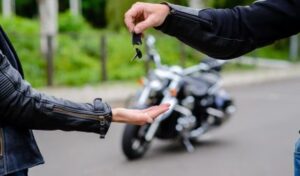Nobody is exempt from a flooded engine; it may happen to any dirt bike. A flooded dirt bike engine isn’t always easy to handle, but here is the complete guide through which you can easily do it yourself in your garage with a small tool.
The simplest repair for a flooded dirt bike is to kick it over eight times while keeping the throttle open wide and the hot start lever pulled in. The flooded cylinder will be cleaned before the throttle is ultimately closed and the engine is kicked. It would be ready for use.
What to do if a dirt bike engine is flooded?
You will need to wait for the gas in the engine to initially disperse for 15 minutes if the dirt bike engine is flooded. If it doesn’t work, shut off the fuel supply, remove out the ignition coil fuse, take out the spark plug, lay a piece of cloth in the spark plug hole very lightly, crank the engine, and spray the cloth with extra gas.
The majority of the numerous dirt bikes I own were no strangers to the flooded engine. I was able to fix this flooded motor several times, and it worked well. Along with learning how to fix a flooded engine, I can also explain a few additional aspects of a flooded dirt bike engine that can be helpful in your circumstance.
Flooded Dirt bike Engine
A motocross bike engine that has flooded should typically not raise quite so many alarms. With the right steps, this is an issue that is very typical and can be quickly resolved. As I already stated, I was an amateur when I first started doing this. There were no problems.
The dirt bike engine should be stopped and left off for at least 15 minutes if it is flooded. By doing this, the engine’s fuel storage can be released.
Some people might be concerned that the gas built up in the flooded engine would seep past the piston rings. This occurs as a result of the engine’s gas and oil mixing.
A small amount of oil was drained and mixed, but it was not enough to modify the oil concentration, so don’t worry if some gases travel through the piston rings. Changing your oil should help resolve the issue, but, if you are concerned.
In a few rare instances, when a dirt bike engine is flooded, too much gas might bypass the piston rings and combine with the engine oil. A damaged piston ring is to blame if this occurs. Since there shouldn’t be too much gas passing through, this is. A significant amount of oil had already burned by that time, as shown by bad piston rings.
Therefore, there is no need to be concerned about gas getting into engine components unless the dirt bike burns a lot of oil. Additionally, the vast majority of the gas that builds up in the container can evaporate from the open valve while you wait.
When the gas does not seem to be shrinking after waiting at least 15 minutes and attempting to restart the dirt bike to re-flood the engine, you should turn to Schedule B with self-draining of the cylinders.
First, you must shut off the fuel tap in order to accomplish this. If you start the engine within a short period of time, this will stop fuel from being added. The fuse attached to the ignition coil needs to be removed next (it is imperative not to skip this step).
To blow a fuse in the ignition coil, some people argue, but I don’t. It’s still possible that the spark plug wire is still receiving some current from the ignition coil. I don’t know what the dangling wire (or, if the spark plug is still attached to the wire, the dangling spark plug) touches while I try to diagnose this problem. By doing this, the gas tank could be grounded or electric shock could occur.
To verify the spark plug’s condition, take out the ignition coil fuse afterward. Make sure the electrode gap—the distance between the spark plug and the hook at the end—is respected and that there is no corrosion.
the spark plug hole with a piece of old cloth that has been lightly inserted. When you start the engine, the compression blows them away and the gas splatters, so it’s crucial not to pack them in there. It sets it such that air can travel through in addition to catching the spray gas.
The engine can now be started. As a result, the spark plug’s perforations in the piston are forced open, allowing gas to enter the fabric.
You need to turn off the gasoline tap, replace the fuse in the ignition coil, replace the spark plug and ignition cable, remove the cloth from the spark plug holes, and then restart the dirt bike after the engine has been running for a while.
Causes of Flooded Engine
If you own a dirt bike, you may have experienced multiple floods with dirt bikes. Or perhaps someone else with an issue has recently come to your attention. Everyone is aware that will eventually occur, but many people are puzzled as to how a dirt bike engine may flood in the first place.
The dirt bike engine will flood if the fuel enters the cylinder properly, but there won’t be a spark to ignite it. As a result, extra fuel is pushed in by the carburettor or injector (typically a carburettor issue). However, since there isn’t a spark to ignite the fuel, it remains in the cylinder and eventually gets replaced. This is referred to as “flooding.”
The air-fuel ratio eventually becomes so far apart that the fuel may not ignite even if there is a spark. There is therefore no space for air to produce the ideal mixture required for burning.
In a nutshell, a failed spark plug that does not produce the spark needed for the engine to burn is the primary cause of flooding in a dirt bike engine. Spark plugs are a straightforward component, but if anything goes wrong, many of these issues can arise.
The spark plug wire and ignition coil may also be to blame. A malfunctioning ignition coil won’t tell the spark plug to begin sparking by sending the incorrect signal through the spark plug wire. Power can flow through the frame as a result of worn or damaged spark plug wires, which will stop the spark plug from sparking at all.
How to find out if flooding of an engine is a problem?
Numerous factors could be at play if a dirt bike won’t start. As a result, figuring out whether the engine is flooded might be challenging. However, some specific signs and symptoms can quickly point to an issue with engine flooding.
The fact that the dirt bike won’t start is, of course, the first symptom. Although the starting mechanism works entirely normally, there is no combustion. The sudden smell of gas is the second most noticeable indicator of engine flooding. Gas in the cylinder can be smelled easily when it builds up. The third warning indication is the presence of fuel spilling or sputtering from the exhaust. Lastly, the pipe can include water. As a result, ensure sure the liquid you are spraying is a gas.
The dirt bike may not start because the engine is flooded if all three of these indications are present. There are various ways to increase the visible evidence that your engine is flooded.
You may check the spark plugs yourself to see whether they are sparking because the lack of sparks from the spark plugs is what is causing the flooding of the engine. Before reattaching the spark plug to the wire, first separate the spark plug wire from the spark plug. Next, remove the spark plug from the engine (just as the spark plug and wire “hang”).
The spark plug’s hook end must then make contact with the engine’s frame or ground. Pay great attention to where you are anchoring. It shouldn’t be crushed up near gas, dangerous substances, or the bottom. The dirt bike tank should not be grounded with the spark plug leads.
Keep the spark plug wire attached once the spark plug has been grounded, then start the engine by pressing the starter button (remove your finger from the spark). If the spark plug ignites, it is a sign that it is not functioning properly.
Any spark plug can be used for this experiment. If none of these function, the ignition coil most likely has a problem. All spark plugs need to be replaced if some of them function and some do not.
How to prevent a dirt bike engine from being flooded
As was already noted, dealing with a flooded engine is unpleasant, and you probably don’t want to go through it again. When maintaining your dirt bike, there are a few things you can do to avoid engine flooding in the future. A faulty spark plug is a significant contributor to flooding in dirt bike engines. Your dirt bike engine’s health depends on regular spark plug maintenance. At the very least once a year, spark plugs should be examined, and if necessary, they should be replaced.
Many individuals are unaware of the significance of the spark plug gap at the end of the spark plug (the distance between the spark plug and the electrode or hook on the back). As a result, consumers frequently purchase spark plugs from auto parts stores, insert them, and go on. While this initially works, it is not very effective over time.
The right spark plug gap needs to be established at the time of purchase. Any auto parts store will sell a spark gap tool for a few bucks. The proper gap space for each spark plug on your dirt bike can be found in the owner’s handbook or online. Use the equipment provided to make the necessary adjustments. Not all automobiles come with spark plugs as standard equipment at the appropriate intervals.
The condition of the spark plug cable should be inspected on a regular basis in addition to spark plug maintenance. If the wire is broken or cracked, it needs to be replaced right away. This is due to the possibility that the wire’s opening could cause current to pass through the dirt bike instead of the spark plug.
How do I start the engine after flooding?
Time may be the greatest cure for a flooded engine. First, open the bonnet of the car and wait as long as you can for the extra petrol to evaporate. Try resuming your bike without accelerating after around 20 minutes.
The spark plugs need to be checked if that doesn’t work. The spark plugs may get flooded and unable to provide enough spark to start the engine if the engine is overfilled with petrol. Check the fuel injector and apply a fuel injector cleaning if you notice that the machine floods frequently.






